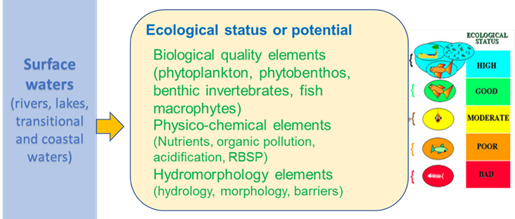Post a comment on the text below
2.1 Introduction
Ecological status[1] is an assessment of the quality of the structure and functioning of surface water ecosystems. It shows the influence of pressures (pollution, habitat degradation, climate change, etc.) over the identified quality elements. Ecological status is determined for each of the surface water bodies of rivers, lakes, transitional and coastal waters based on biological quality elements, supporting physico-chemical and hydromorphological quality elements (Figure 2.1). The overall ecological status classification for a water body is determined, according to the one-out-all-out principle, by the worst status of all the biological quality elements and the supporting quality elements.
Figure 2.X. Assessment of ecological status of surface water bodies

You cannot post comments to this consultation because you are not authenticated. Please log in.



Previous comments
Figure 2.X:
The presentation of the ecological status / potential in figure 2.X is to our opinion misleading. There is no visible differentiation between biological quality elements and supporting physiical and chemical quality elements (including hydromorphology). As in Germany and to our knowledge in most MS the ecological status / potential is determined by the biological quality elements only. The physical and chemical quality elements (including hydromorphology) are only used supportive. Please change figure 2.X accordingly (separate biological QE`s from other supportive QE`s).
The ecological potential classification only distinguishes 4 classes and these should be added to this figure.
Please add some sentences to describe the general difference between "status" and "potential" in the report.
For example:
Heavily modified and artificial waters are distinguished from natural waterbodies. These were either created artificially (e.g. a canal), or else their structure
has been modified so extensively that a “good ecological status” can no longer be achieved without significantly impairing an existing, economically significant
water use that cannot be achieved by other means. For such waters, an equally ambitious environmental objective of a “good ecological potential” has been defined, which requires improvements to be made to the hydromorphological pressures without impairing non-substitutable water uses. However, chemical status applies in exactly the same way as for natural waterbodies.
or
For “heavily modified” and “artificial” water bodies, the EU Water Framework Directive prescribes the objective of “good ecological potential”. “Maximum ecological potential” is the reference status for heavily modified water bodies. At maximum ecological potential, all measures have been taken to improve the morphology of the water body without restricting its anthropogenous
usage. A “good ecological potential” represents only a minimal deviation of the biotic community from that of “maximum ecological potential”.
"...coastal waters based on biological quality elements, supporting...."
Proposal: "supported by" instead of supporting
"The overall ecological status classification for a water body is determined, according to the one-out-all-out principle, by the worst status of all the biological quality elements and the supporting quality elements."
This is misleading. One-out-all-out is mainly for biological quality elements, hydromorphology is classifying only from high to good.
"Figure 2.X. Assessment of ecological status of surface water bodies"
Figure 2.1 in this case and adjust numbers of all following figures in chapter 2.
(AT): 1st word in 1st sentence 'Ecological status....'
The footnote is not correct! ”the ecological conditions they reflect are assumed to be comparable, having the same deviation from reference conditions”
The ecological conditions are not comparable. Only WBs failing good status can be designated as HMWB. Reference conditions (high status) and high potential differ significantly. This needs better explanations! The main diffferences between natural and HMWB/AWB should be explained in chapter 1.2
As 17% of all WB are AWB/HMWB a chapter on the results for ecological potential would be reasonable! It is not acceptable to include ecological potential in ecological Status!
(AT) Figure 2.X
Separate colour code for AWB/HMWB